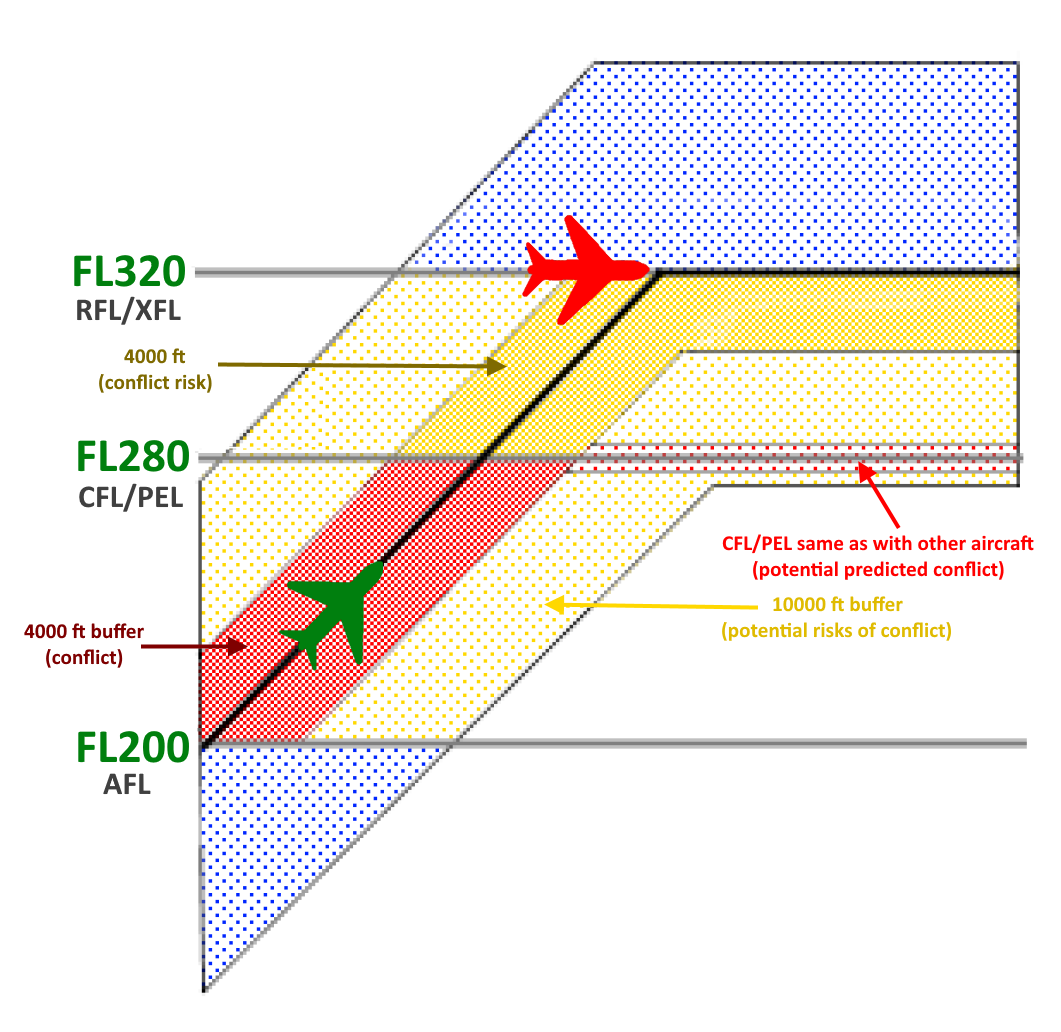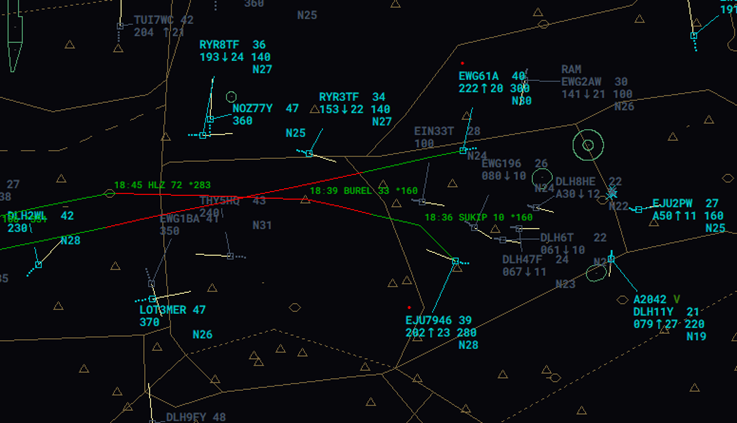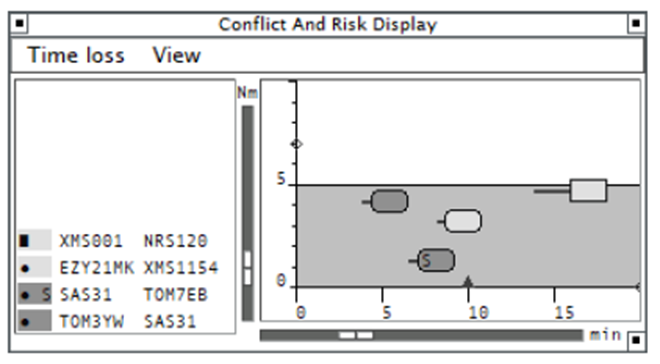Medium Term Conflict Detection (MTCD)
General
Medium-Term Conflict Detection (MTCD) is a flight data processing system designed to predict future conflicts between flights in the controller's area of responsibility over a time horizon of up to 20 minutes.
MTCD aims to facilitate a move from the current largely reactive form of air traffic control to more proactive control. This would thereby balance more evenly the workload of tactical and planning tasks, enhance sector efficiency, and provide an even safer and better service to airspace users.
MTCD is a natural extension of the Short Term Conflict Alert (STCA) concept. However, while STCA is a safety net function and its objective is solely to improve the safety of ATC service provision, MTCD is a controller tool supporting pre-planning. Therefore, both tools serve different purposes.
System Functions
The MTCD system works by checking the aircraft’s predicted route up to the defined prediction time and calculating if the separation with other aircraft will be less than the defined prediction distance. In case the predicted distance is less than the defined separation minimum, the MTCD system will notify the controller with a specific warning. The planned trajectory will be updated constantly.
Explanation of the 4D Setup
The MTCD system will check for lateral distances along the predicted lateral trajectory. Lateral separation less than the defined minimum separation will result in an MTCD conflict warning.
Additionally, the MTCD system programmed in the 4D setup will also check for the vertical separation along the vertical trajectory. In this case, a 4000 ft buffer will be applied to the current climb profile (similar to the 1 NM buffer for the lateral MTCD prediction).
Example:
In the picture below, the green aircraft should climb from FL200 to FL320, which is the requested final flight level for this aircraft. As FL320 is already occupied by the red aircraft, the controller decides to instruct a step-climb to FL280 instead. Once the new CFL is entered in the aircraft label, the MTCD system will look for conflicts along the route, considering the current ground speed and current rate of climb.
As the prediction of the trajectory can be somewhat inaccurate, the system looks for conflicts that would occur within the lateral buffer of the aircraft if the vertical separation between both aircraft is predicted to be within the 4000 ft buffer (red shaded area).
This means that an aircraft at FL260 with a lateral distance of less than the required lateral separation would not show, if the MTCD system calculated that both aircraft would meet at a vertical separation of 6000 ft.
Note: A conflict will only be shown if both aircraft vertically meet within the 4000 ft buffer of the predicted climb profile and if the lateral distance between both aircraft is less than the defined separation minimum.
In this example, both EWG61A and EJU7946 are predicted as a conflict by the MTCD system. Even though both aircraft are currently separated by 2000 ft to their actual flight level (AFL) and also 2000 ft to their cleared flight level (CFL), the system detects that EJU7946 has a higher climb rate than EWG61A. Due to that, the 4000 ft buffer will not be maintained. As both aircraft will roughly meet at the same point with a separation of less than 5 NM, a conflict warning will be shown by the MTCD system.
Note: MTCD conflict warnings will be shown as a red segment on the aircraft's route, a red dot above the aircraft's callsign and/or as an MTCD warning above the aircraft's callsign in the detailed label.
Additionally, the MTCD system will also look at what would happen in the future if the controller issues a further climb clearance to the requested flight level (RFL) or planned exit level (XFL). Taking into account the same buffers as for the conflict, so-called conflict risk is displayed in the dark yellow shaded area.
In our graphic, the system would not show any conflict warning, as there is no traffic penerating the green aircraft's buffer for the climb from FL200 to FL280, but the system will show a conflict risk warning in yellow to warn the controller that a conflict will exist in case the green aircraft is cleared to FL320. This would result in a conflict with the red aircraft.
Note: A conflict risk warning will always immediately result in a full conflict warning if the warning is ignored by the controller.
Here, no conflict exists, as UAE321 is cleared to FL160 and DLH1EK is maintaining FL200. Therefore, the MTCD system will not show any red conflict warning. But the system predicts that once the vertical separation is not ensured anymore, both aircraft will result in a conflict as the lateral separation will be less than required.
This helps the controller spot potential cleared conflicts. In case the controller instructs UAE321 to continue the climb to FL210, the MTCD warning will change from a conflict risk to a conflict, and therefore will change colour from yellow to red. The same applies if the DLH1EK would get a descent instruction below FL170.
Remember: A red MTCD warning always needs to be solved, as great potential for a (cleared) conflict exists. Yellow warnings only warn the controller about future clearances and will turn to conflict warnings if ignored.
Besides the conflict warning and conflict risk warning, other warnings exist:
- Potential risk conflicts: Calculate the same area as for conflicts and conflict risks, but with a buffer of 10000 ft (instead of 4000 ft).
- Potential predicted conflicts: Will show conflicts that would occur in case the aircraft stays on the CFL/PEL in the future and does not get a further climb as assumed. In our example, a potential predicted conflict could occur in case the green aircraft stays at FL280 for some time, in case another aircraft is also at FL280.
- Potential conflicts (blue): Traffic crossing at a lateral distance less than the required minimum separation, but way outside of the vertical buffer.
Note: The detection of potential predicted conflicts and potential risks of conflict can be disabled, in which case they will be converted to potential conflicts. In most cases, the conflict warning and conflict risk warning are sufficient for pre-planning and conflict solving.
Weak Points
Remember that the MTCD is to be used for pre-planning only. As the MTCD calculation is not exactly accurate, which is also a result of the buffer being larger than the required minimum separation, false warnings can occur. Additionally, the planned trajectory solely relies on the current aircraft's conditions, such as ground speed and climb/descent rate. Whenever one of these values changes unexpectedly, the result of the MTCD warning can change as well.
Remember: Every MTCD conflict warning always need to be checked by the controller by applying other measures such as SEP-Tools and/or QDMs.
Also, MTCD can not be used for actual short-term conflict alerts, and it also does not support any aural warnings.
Conflict and Risk Display (CARD)
The CARD window presents the MTCD conflicts and conflict risks. This window greatly helps the controller to spot any conflicts in the area calculated by the MTCD system. The CARD can be very useful during periods of high traffic and lets the controller better detect and manage predicted conflicts.
On the left side of the window, the conflicting aircraft pairs will be listed. Hovering the mouse cursor above the aircraft pair will display the route of both aircraft, highlighting the MTCD conflict warning on the aircraft's route. With a left click on the aircraft pair, the predicted conflict warning can be acknowledged by the controller if the conflict is not relevant to the controller.
Note: Conflicts not relevant to the controller should always be acknowledged, turning the MTCD warning to grey. This helps to keep a better overview of conflicting aircraft in the sector.
On the right side of the CARD, the conflicting aircraft pairs will be shown along a vertical (distance) axis and horizontal (time) axis. The left side of the conflict label in the display shows the time till to the point of closest approach. A line in “CARD Time Vector” colour, extending to the left from the label, marks the time when the separation will decrease below the prediction distance. If a SEP-Tool (min SEP) is displayed for the conflict pair on the radar screen, an “S” is displayed on the label of the aircraft's conflict pair in the CARD.




